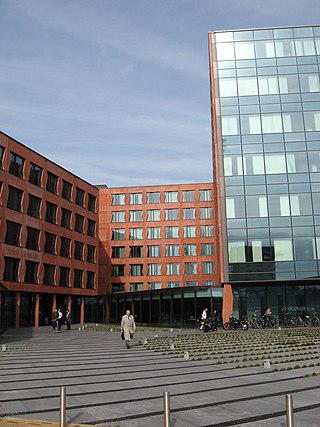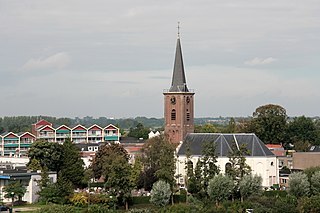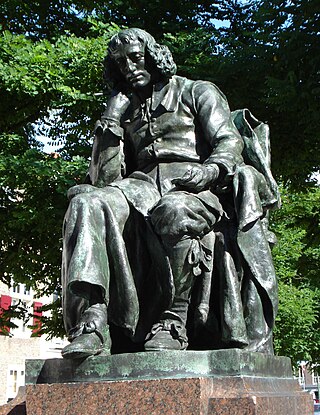Related Research Articles

The International Organization for Migration (IOM) is a United Nations agency that provides services and advice concerning migration to governments and migrants, including internally displaced persons, refugees, and migrant workers.

Demographic features of the population of the Netherlands include population density, ethnicity, education level, health of the population, economic status, religious affiliations and other aspects of the population.

Statistics Netherlands, founded in 1899, is a Dutch governmental institution that gathers statistical information about the Netherlands. In Dutch it is known as the Centraal Bureau voor de Statistiek, often abbreviated to CBS. It is located in The Hague and Heerlen. Since 3 January 2004, Statistics Netherlands has been a self-standing organisation, or quango. Its independent status in law guarantees the reliable collection and dissemination of information supporting public debate, policy development and decision-making.

Mijdrecht is a town in the Netherlands with about 16,000 residents. It is located in the municipality of De Ronde Venen, about 7 kilometres (4.3 mi) west of the main A2 motorway, between Utrecht and Amsterdam.
Allochtoon is a Dutch word, literally meaning "emerging from another soil". It is the opposite of the word autochtoon, literally meaning "emerging from this soil".
Turks in the Netherlands refers to people of full or partial Turkish ethnicity living in the Netherlands. They form the largest ethnic minority group in the country; thus, the Turks are the second-largest ethnic group in the Netherlands after the ethnic Dutch. The majority of Dutch Turks descend from the Republic of Turkey; however, there has also been significant Turkish migration waves from other post-Ottoman countries including ethnic Turkish communities which have come to the Netherlands from the Balkans, the island of Cyprus, as well as from other parts of the Levant. More recently, during the European migrant crisis significant waves of Turkish minorities from Syria and Kosovo have also arrived in the Netherlands. In addition, there has been migration to the Netherlands from the Turkish diaspora; many Turkish-Belgians and Turkish-Germans have arrived in the country as Belgian and German citizens.
Cape Verdeans in the Netherlands consist of migrants from Cape Verde to the Netherlands and their descendants. As of 2022, figures from Statistics Netherlands showed 23,150 people of Cape Verdean origin in the Netherlands.
Filipinos in the Netherlands comprise migrants from the Philippines to the Netherlands and their descendants living there. According to Dutch government statistics, 16,719 persons of first or second-generation Philippine background lived in the Netherlands in 2011. Though Filipinos live throughout the country, Amsterdam and Rotterdam are homes to the largest Filipino communities.
Moroccans in the Netherlands They are Dutch citizens and nationals ethnic group, of the Kingdom of Netherlands with Dutch citizenship and a Dutch passport of Moroccans origin, immigrants from Morocco to the Netherlands and their descendants they are the second largest ethnic group in the Netherlands.

Bulgarian-Dutch relations are foreign relations between Bulgaria and the Netherlands. Bulgaria has an embassy in The Hague. The Netherlands has an embassy in Sofia. Both countries are members of the European Union and the NATO. the Netherlands has given full support to Bulgaria's membership in the European Union and NATO.
Koreans in the Netherlands form one of the smaller Korean diaspora groups in Europe. As of 2022, 9,469 people of Korean origin lived in the Netherlands.
Chinese people in the Netherlands form one of the largest overseas Chinese populations in continental Europe. In 2018 official statistics showed 92,644 people originating from the People's Republic of China (PRC) and Republic of China (ROC), or people with at least one such parent. However, these statistics do not capture the whole size of the Chinese community, which since its earliest days has included not just migrants from China, but people of Chinese ethnicity drawn from among overseas Chinese communities as well.
Vietnamese people in the Netherlands form one of the smaller overseas Vietnamese communities of Europe. They consist largely of refugees from the former South Vietnam, Vietnamese born-citizens and their descendants.
Iranians in the Netherlands form one of the newer and larger populations of the Iranian diaspora in Europe. Iranians in the Netherlands are referred to by hyphenated terms such as Dutch-Iranians, Iranian-Dutch, Dutch-Persian, or Persian-Dutch. Similar terms Iraanse Nederlanders, Nederlandse Iraniërs, and Perzische-Nederlanders may be found in Dutch-language media.
Dutch Afghans are Dutch citizens and non-citizen residents born in, or with ancestors from, Afghanistan. In 2015 there were 44,000 Dutch Afghans, which form one of the largest Afghan diaspora communities as well as one of the main Asian communities in the Netherlands. Most of the first generation population originally settled in the Netherlands between 1992 and 2001.
Somalis in the Netherlands are residents or naturalized citizens of the Netherlands who are of Somali ancestry. They form one of the larger Somali communities in Europe and amongst the second largest African foreign community in the Netherlands. The Somalis form the second largest African community in The Netherlands and are one of the fastest growing communities.
There is a small community of Nigerians in the Netherlands, which began to grow in the late 1980s.

Portuguese in the Netherlands are the citizens or residents of the Netherlands whose ethnic origins lie in Portugal.
Hongkongers in the Netherlands are people in the Netherlands originated from Hong Kong or having at least once such parent.

Netherlands–Spain relations are the bilateral and diplomatic relations between these two countries. The relations between both countries are defined mainly by their membership in the European Union and by being allies in the NATO, as well as belonging to numerous International Organizations.
References
Notes
- 1 2 "CBS Statline". opendata.cbs.nl (in Dutch). Retrieved 2023-07-18.
- ↑ Brons & Schaap 2002, p. 15
- ↑ Laarman 2007, p. 130
- 1 2 3 Sysling, Fenneke (2007-07-20), "Nederland in trek bij Angolezen/Netherlands in vogue with Angolans", Trouw, retrieved 2009-09-04
- ↑ "Nederland populairst bij Angolezens/Netherlands most popular with Angolans", Trouw , 2001-09-01, retrieved 2009-09-04
- ↑ Moleman, Hans (2002-07-02), "Angolese jongeren zien Nederland als paradijs", de Volkskrant , retrieved 2009-10-11
- ↑ "Kalsbeek: Angolezen terug/Kalsbeek: Angolans, go back", Trouw, 2001-05-30, retrieved 2009-08-04
- ↑ "Angolese asielzoekers hoeven nog niet terug/Angolan asylum-seekers will not go back", Trouw, 1999-07-02, retrieved 2009-09-04
- 1 2 IOM 2006 , p. 7
- ↑ IOM 2006 , p. 10
- ↑ IOM 2006 , p. 6
- ↑ van Wijk 2008
- ↑ "CBS Statline". opendata.cbs.nl (in Dutch). Retrieved 2023-07-21.
- ↑ "Brasileiros no exterior" (PDF).
- ↑ "Observatório da Emigração". observatorioemigracao.pt (in Portuguese). Retrieved 2023-07-14.
- ↑ CBS 2009; the year 1996 is the earliest for which statistics are available online
- ↑ Laarman 2007 , p. 136
Sources
- Brons, Maria; Schaap, Caroline (2002), Profile analysis of Angolans in the Netherlands, Pilot Project: Prepared Return, The Hague: International Organization for Migration, archived from the original on 2011-07-22
- Research into the determinant factors for return of Angolans from the Netherlands, Research Reports, The Hague: International Organization for Migration, 2006, archived from the original on 2011-07-22
- Laarman, Charlotte (2007), "De Portugeestalige migranten en hun parochies in de Nederlandse Katholieke Kerk, 1969-2005/Lusophone migrants and their parishes in the Dutch Roman Catholic church, 1969-2005" (PDF), Tijdschrift voor Sociale en Economische Geschiedenis, 4 (1): 117–142, archived from the original (PDF) on 2011-07-24, retrieved 2009-10-11
- van Wijk, Joris (2008), "Luanda – Holanda: Irregular migration from Angola to the Netherlands", International Migration, 48 (2): 1–30, doi:10.1111/j.1468-2435.2008.00485.x
- Population by origin and generation, 1 January, The Hague: Centraal Bureau voor de Statistiek, 2009, retrieved 2009-10-11